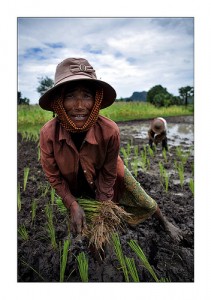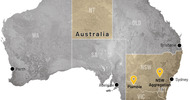Thursday, February 4, 2010
dap-news.com
PHNOM PENH – Cambodia’s Prime Minister Hun Sen announced another ambitious plan to invest US$310 million including the Chinese loans of US$240 million for improving the kingdom’s irrigation systems, which are the key factors contribute to boost rice production for exports.
“Good irrigations enables us to produce more crops and yield production, which boost for exports but to reach that we need more irrigations,” Hun Sen said at a ceremony of a China-funded construction in the Northwestern province of Batttambang.
The money will be mostly channeled through the ministry of water resources.
Hun Sen also said that “if you get on the plane and look below, you can see vast area of lands, but it looks dry and grey... because of shortage in irrigations. That means we could export more rice when we have enough water to support rice cultivation.”
He said Thailand and Vietnam have invested in agricultural sector to a full extend, yet for Cambodia has more rooms of opportunities for such investment.
“Once we can export more rice, it will also contribute to the global food security.”
“We are transforming the former battle fields as cultivated areas. We are transforming the former war zones as development area and markets,” the Prime Minister’s speech was aired on state-run TVK.
Many analysts said Cambodia’s potential investment in rice is high but opportunities for increased exports have been limited because of poor irrigations and processing facilities.
Agricultural minister Dr. Chan Sarun has said before that Cambodia’s area planted for rice could be pushed up to 3.5 million hectares from 2.6 million, giving a potential harvest of 12.25 million tonnes. Average rice yield expects to reach 3.5 tonnes per hectare in 2015 from 2.6 tonnes, he said. “More cultivated areas, higher yield, and double crops will contribute to 15 million of rice,” Sarun has said. He said many rice producing countries have invested at the maximum level, not yet for Cambodia. The outside analysts say it might be a possibility, but not by 2015—worrying that Cambodia needs more time to develop, farming skills. Cambodia also looks to expand in the northeast and in former battlefields of the nation's civil war in the northwestern. Other questioned about landmines hinders the potential cultivated area, but agriculture minister shrugged off and said: “We do not have to wait for de-mining.” Just around Tonle Sap, Cambodia's biggest freshwater lake, has potential farm land of “more than 800,000 hectares”, he said. “These areas are rich in fertilizer and to produce high yield,” said Dr. Sarun. He is also shared viewed with the local rice researcher who has said that the country could achieve up to 15 million tonnes of rice by year 2015. “More cultivated areas, higher yield, double crops will contribute to 15 million of rice,” Sarun told has said before. “We won’t be the top rice exporter, but we will have lots of rice for export by 2015,” agriculture minister Chan Sarun said. According to the U.S. Department of Agriculture (USDA) Cambodia was the world's ninth-biggest exporter in 2007 with 450,000 tonnes. This Southeast Asian nation expects to export up to 8 million tonnes from expansion of cultivated areas—a figure that would put it just behind fellow Thailand. Cambodia has been successful with rice production in the last decade and this prospect remains unchanged. The kingdom produced 7.286 million tonnes of rice for 2009/2010 of which the country saw another surplus of rice of 3.1 million tonnes available for export. The high potential in rice investment has intrigued not only China, which is Cambodian biggest donor, but other donors as well—given the country’s agricultural sector is the nation’s backbone economy. China has pledged more loans for Cambodia to invest more in constructing irrigations in Prey Veng, Pursat and Oddar Meanchey. Last October, Beijing pledged another US $853 million in loans for Cambodia to invest in building more infrastructure, irrigation, and dam projects to boost its economy and reduce poverty. The announcement was made during the meeting between Chinese Premier Wen Jiabao met Cambodia's Prime Minister Hun Sen on the sidelines of an economy and trade fair in Sichuan. Water Resource ministry official said the ministry would seek multi-millions to investment more in irrigations. “Japan and South Korea are also helping us, but that is not enough,” Chea Chhun Keat of the water resource ministry has said before. He also said that irrigations have so far covered 1.6 million hectares out of 2.6 million. Investments from Kuwait and Qatar are the plus. Kuwait also agreed to loans Cambodia of $546 million of which some $486 million will be invested in irrigation systems and hydro-power in the northeast, and remain $60 million goes for roads in the north-western province of Battambang, a rice-growing area.Kuwait, which had leased rice fields in Cambodia to secure food supplies, planned to invest $200 million in Cambodian farmland, said a Kuwait newspaper.
“They have money, we have land. They won’t come if we do not have agricultural potential,” Chan Sarun has said before.













